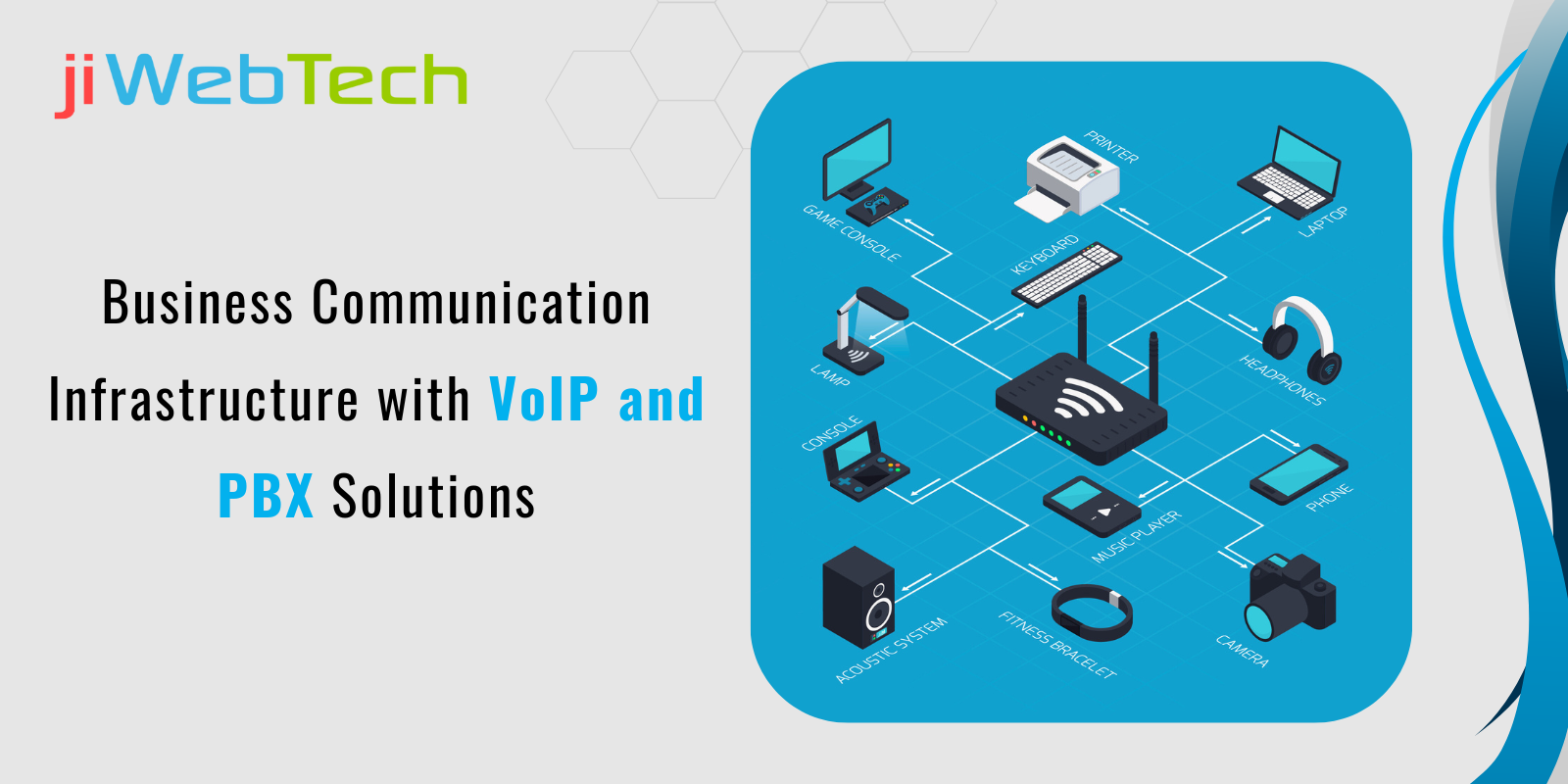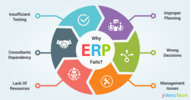- Sep 05, 2025
- Communication
- 1836
Share this post on:

Business communication infrastructure has undergone a profound transformation with the advent of Voice over Internet Protocol (VoIP) and modern Private Branch Exchange (PBX) solutions. These technologies have reshaped how businesses manage internal and external communications, offering enhanced flexibility, scalability, cost efficiency, and advanced features that were difficult or impossible to achieve with traditional telephony systems.
This blog explores the business communication infrastructure enabled by VoIP and PBX solutions, detailing their evolution, components, key benefits, and how they are revolutionizing corporate communication.
Understanding Business Communication Infrastructure
At its core, business communication infrastructure encompasses the systems and technologies companies use to communicate internally among employees and externally with customers, partners, and other stakeholders. Historically, this involved traditional PBX systems with analog phone lines, fax machines, and email systems functioning independently. However, demands for more integrated, flexible, and cost-effective solutions encouraged the shift toward IP-based communication solutions.
What is VoIP and How Does it Impact Business Communication?
Voice over Internet Protocol (VoIP) allows voice communication and multimedia sessions to be transmitted over Internet Protocol (IP) networks such as the Internet. This contrasts with traditional communication, which relied on Public Switched Telephone Network (PSTN) circuits. VoIP enables businesses to make and receive telephone calls via the internet, offering:
- Lower communication costs due to reduced dependence on legacy phone lines and lower international call rates.
- Enhanced flexibility and mobility, allowing employees to connect from anywhere.
- Integration with other digital services such as video conferencing, instant messaging, and email.
- Improved call quality and features depending on the network setup.
Evolution of PBX to IP PBX with VoIP Integration
A PBX (Private Branch Exchange) is an internal telephone network within an organization that manages call routing between internal users and external lines. Traditional PBX systems operated on circuit-switched networks and required extensive physical hardware and wiring. With the rise of VoIP, PBX systems evolved into IP PBX systems, which use IP technology for call signaling and management. IP PBX combines the internal call management features of traditional PBX with the open, internet-based transmission of VoIP technology. Key changes include:
- Moving call routing responsibilities from hardware to software running on an IP PBX server.
- Connecting IP phones and softphones over the LAN and WAN.
- Enabling calls over the internet or private IP networks, reducing dependency on analog lines.
- Integration with business applications like CRM systems.
Core Components of a VoIP PBX Business Communication Infrastructure
- IP PBX Server: The central system manages call routing, signaling, and features. It controls internal extensions and external call connections.
- IP Phones and Softphones: Devices (hardware phones or software clients) allowing employees to make and receive calls over the IP network.
- VoIP Gateway (Optional): Connects the IP PBX to traditional PSTN lines to allow calls to and from traditional phone networks when needed.
- Network Infrastructure: Reliable and high-speed IP networks (LAN, WAN, or internet) to carry voice and multimedia traffic.
- Management Interface: Usually web-based consoles or apps that allow administrators to configure the system, extensions, call routing rules, and monitor system health.
- Integration Interfaces: APIs and connectors to integrate with CRM, helpdesk software, email, workflow tools, and unified communication platforms.
Key Features of VoIP PBX Solutions
VoIP PBX solutions come loaded with advanced features designed to enhance communication efficiency:
- Advanced Call Management: Call forwarding, call waiting, call transfer, call parking, voicemail-to-email, and do-not-disturb controls.
- Auto-attendant and IVR: Interactive voice response systems to automate greetings and route calls to the correct departments or personnel.
- Unified Communications: Integration of voice, video, instant messaging, email, and conferencing into a single platform, facilitating smoother collaboration.
- Mobile and Remote Access: Employees can use mobile apps or softphones to stay connected from anywhere, supporting remote work.
- Call Recording and Analytics: For quality assurance, compliance, and performance tracking.
- Virtual Extensions and Numbers: Create extensions that forward calls to mobile devices or different locations.
- Scalability: Easily add or remove lines and features as the business grows or requirements change.
- Enhanced Security: Encryption, secure SIP trunking, firewalls, and authentication mechanisms safeguard communications.
- Cost Efficiency: Lower operational costs due to internet-based calls and fewer hardware requirements.
Advantages of Integrating VoIP with PBX for Business Communication Infrastructure
- Cost Savings: Switching to VoIP PBX systems can substantially reduce telecom costs due to less reliance on traditional phone lines. Lower call rates, especially for international calls, and reduced hardware and maintenance expenses contribute to significant savings.
- Flexibility and Mobility: VoIP PBX grants employees the freedom to work from anywhere via smartphones, laptops, or IP phones connected to the internet. This flexibility is crucial in hybrid work environments and global businesses.
- Scalability and Future-Proofing: VoIP PBX systems allow businesses to easily scale their communication infrastructure, adding new users or features without complex rewiring or hardware replacements. Cloud-based and hybrid deployment options add further agility.
- Enhanced Collaboration: Unified communication platforms enabled by IP PBX systems integrate various channels, promoting faster decision-making and better teamwork across departments and locations.
- Improved Customer Experience: Features like IVR systems and call queuing ensure calls reach the right agents promptly. Call recording and analytics help organizations monitor service quality and improve customer interactions.
- Simplified Administration: Web-based management consoles allow administrators to configure system settings remotely without needing specialized telephony expertise, improving administrative efficiency.
Deployment Options: On-Premise, Cloud, and Hybrid PBX Systems
VoIP PBX solutions can be deployed in different ways depending on business requirements:
- On-Premise PBX: Hardware and software are installed and maintained in the company’s data center or server room. Provides full control but requires upfront investment and IT expertise.
- Cloud PBX (Hosted PBX): Cloud PBX systems are hosted and managed by external providers over the internet. The business accesses the system via devices connected online, benefiting from lower initial costs, easier scalability, and reduced maintenance.
- Hybrid PBX: A combination where some telephony infrastructure is on-site while other features are cloud-based, offering a balance between control and flexibility.
Industry Use Cases and Applications
- Small and Medium Enterprises (SMEs): VoIP PBX offers SMEs affordable, feature-rich phone systems that are easy to scale as they grow.
- Large Enterprises: Support for multi-location connectivity, integrations with enterprise applications, and advanced analytics make VoIP PBX suitable for large organizations.
- Customer Support Centers: Call routing, recording, and IVR help deliver prompt and efficient customer service.
- Remote and Distributed Teams: Employees stay connected through mobile apps and softphones, ensuring productive communication regardless of location.
Challenges and Considerations in Deploying VoIP PBX Solutions
- Network Reliability and Bandwidth: Since VoIP calling depends on IP networks, businesses must ensure they have stable internet connections with sufficient bandwidth.
- Security Risks: VoIP systems can be targets for cyberattacks. Robust encryption and security protocols are essential.
- Quality of Service (QoS): Network optimization is needed to minimize latency, jitter, and packet loss that can degrade call quality.
- Integration Complexity: Seamless integration with existing business applications may require technical expertise and proper planning.
- Transition Management: Migrating from traditional PBX to IP PBX systems requires careful change management to avoid disruption.
Future Trends in VoIP and PBX Business Communication Solutions
- Artificial Intelligence (AI): AI-powered voice assistants and analytics will further enhance call handling and customer interactions.
- 5G Networks: Higher bandwidth and lower latency will improve VoIP call quality and mobile communication flexibility.
- Unified Communication as a Service (UCaaS): Cloud-delivered integrated communication platforms will gain wider adoption.
- Enhanced Security: Increasing the sophistication of security measures will protect businesses against evolving cyber threats.
- Internet of Things (IoT) Integration: Communication systems will connect with smart devices, improving operational workflows.
Conclusion:
Business communication infrastructure is undergoing a profound transformation, driven by the adoption of VoIP and PBX solutions. These technologies offer businesses unprecedented flexibility, cost savings, scalability, and advanced communication capabilities essential for competing in today’s digital economy.
By understanding the interplay between VoIP and PBX and carefully selecting the right solutions tailored to their needs, businesses can create a resilient and future-proof communication system that enhances collaboration, improves customer experience, and drives growth.
jiWeb Technologies is a leading online software solution provider company, offering the best communication solutions to businesses worldwide, helping them streamline communication. Feel free to contact us today.
Frequently Asked Questions
1. What is a VoIP PBX system, and how does it benefit business software solutions?
A VoIP PBX system is a Private Branch Exchange that uses Voice over Internet Protocol (VoIP) to route calls over the internet instead of traditional phone lines.It benefits businesses by reducing communication costs, enhancing flexibility and mobility, enabling advanced call features, and integrating various communication channels like voice, video, and messaging into one platform.
2. What are the main components of a VoIP PBX communication infrastructure?
Key components include the IP PBX server (which manages call routing), IP phones or softphones (hardware or software clients for calls), optional VoIP gateways (to connect with traditional PSTN lines), a reliable network infrastructure, management interfaces for system configuration, and integration interfaces for linking with CRM and other business applications.
3. Can VoIP PBX systems support remote and mobile employees?
Yes, VoIP PBX systems support remote and mobile work by allowing employees to use mobile apps or softphones connected to the internet. This ensures seamless communication from any location, essential for hybrid or distributed teams.
4. What deployment options are available for VoIP PBX systems?
Businesses can choose from three main deployment models:
On-Premise PBX: The system is installed and maintained at the company’s location, offering full control but requiring more IT resources.
Cloud PBX (Hosted PBX): The system is hosted by a third-party provider and accessed over the internet, reducing upfront investment and easing scalability.
Hybrid PBX: Combines on-premise hardware with cloud services to balance control and flexibility.
5. What security considerations should businesses keep in mind when deploying a VoIP PBX?
VoIP systems must be secured against cyber threats using encryption, secure SIP trunking, firewalls, and robust authentication protocols. Additionally, network reliability and bandwidth must be ensured to maintain call quality and prevent disruptions.









